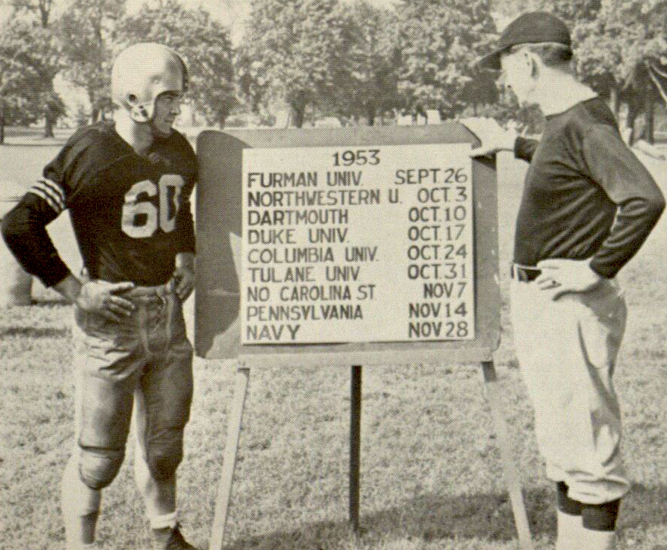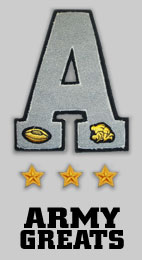
Home
Classes
Coaches
Army Greats
Army Lore
Teams
Of Interest...
About
Submissions
Contact
Newsletter
Credits
Click on small photos
 Cadet will not Lie, Cheat, Steal, or Tolerate Those Who Do Cadet will not Lie, Cheat, Steal, or Tolerate Those Who Do
 USMA at West Point USMA at West Point
 We have changed the wording of our Alma Mater to reflect the fact that our Women Graduates have also given their lives serving this Nation.
We have changed the wording of our Alma Mater to reflect the fact that our Women Graduates have also given their lives serving this Nation.
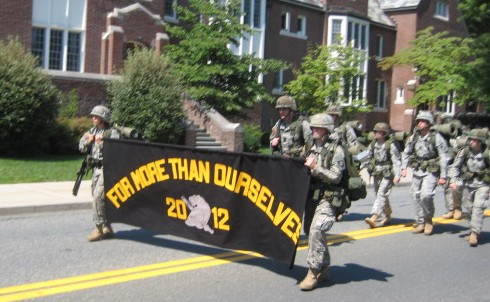 ----- Class of 2012 Motto ------ - "For More Than Ourselves" -Thank you Class of 2012 - for the Honor of Marching with you
The Class of 62 - Can Do ----- Class of 2012 Motto ------ - "For More Than Ourselves" -Thank you Class of 2012 - for the Honor of Marching with you
The Class of 62 - Can Do
 Remember - The Soldiers you will lead Always Come First Remember - The Soldiers you will lead Always Come First
 Motto -- Duty Honor Country Motto -- Duty Honor Country
 The Cadets of West Point
The Cadets of West Point
 They played perhaps Army's Greatest Game. They were the Team that Gave The Most They played perhaps Army's Greatest Game. They were the Team that Gave The Most
 Washington's Letter recommending the establishment of the Academy and the History of West Point
Washington's Letter recommending the establishment of the Academy and the History of West Point

The Oaths We Take
 West Points Medal of Honor Winners West Points Medal of Honor Winners
 Jefferson Hall - the Academy's new Library.
Jefferson Hall - the Academy's new Library.
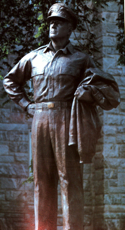 Douglas MacArthur
Douglas MacArthur
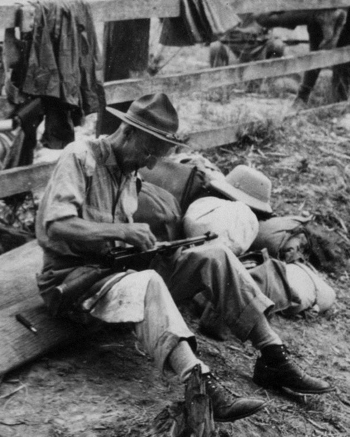
Vinegar Joe Stilwell cleaning his Thompson -The Walkout -Burma 1942
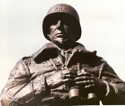 George Patton
George Patton
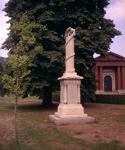 The Monuments of West Point
The Monuments of West Point
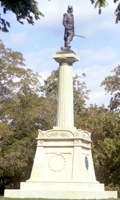 Kosciuszko Monument - Guarding the Hudson ensuring there is no passage of British Man of War
Kosciuszko Monument - Guarding the Hudson ensuring there is no passage of British Man of War
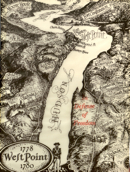 Forts of the Hudson
Forts of the Hudson
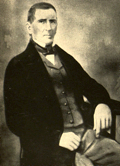
So we'll sing our reminiscences of Benny Havens, Oh!
 Academic Excellence Academic Excellence
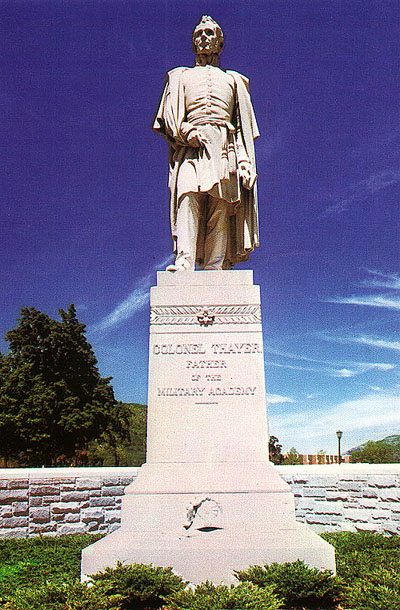 ---- Colonel Thayer ---- Colonel Thayer
 West Point West Point
 Trophy Point Trophy Point
 L'Ecole Polytechnique Monument, or The French Monument by Cadets L'Ecole Polytechnique Monument, or The French Monument by Cadets
 Superintendent's Quarters viewed from Thayer Road Superintendent's Quarters viewed from Thayer Road
 Superintendant was not Happy
Black '57
Superintendant was not Happy
Black '57
 Home of the Dean Home of the Dean
 Quarters 104 Quarters 104
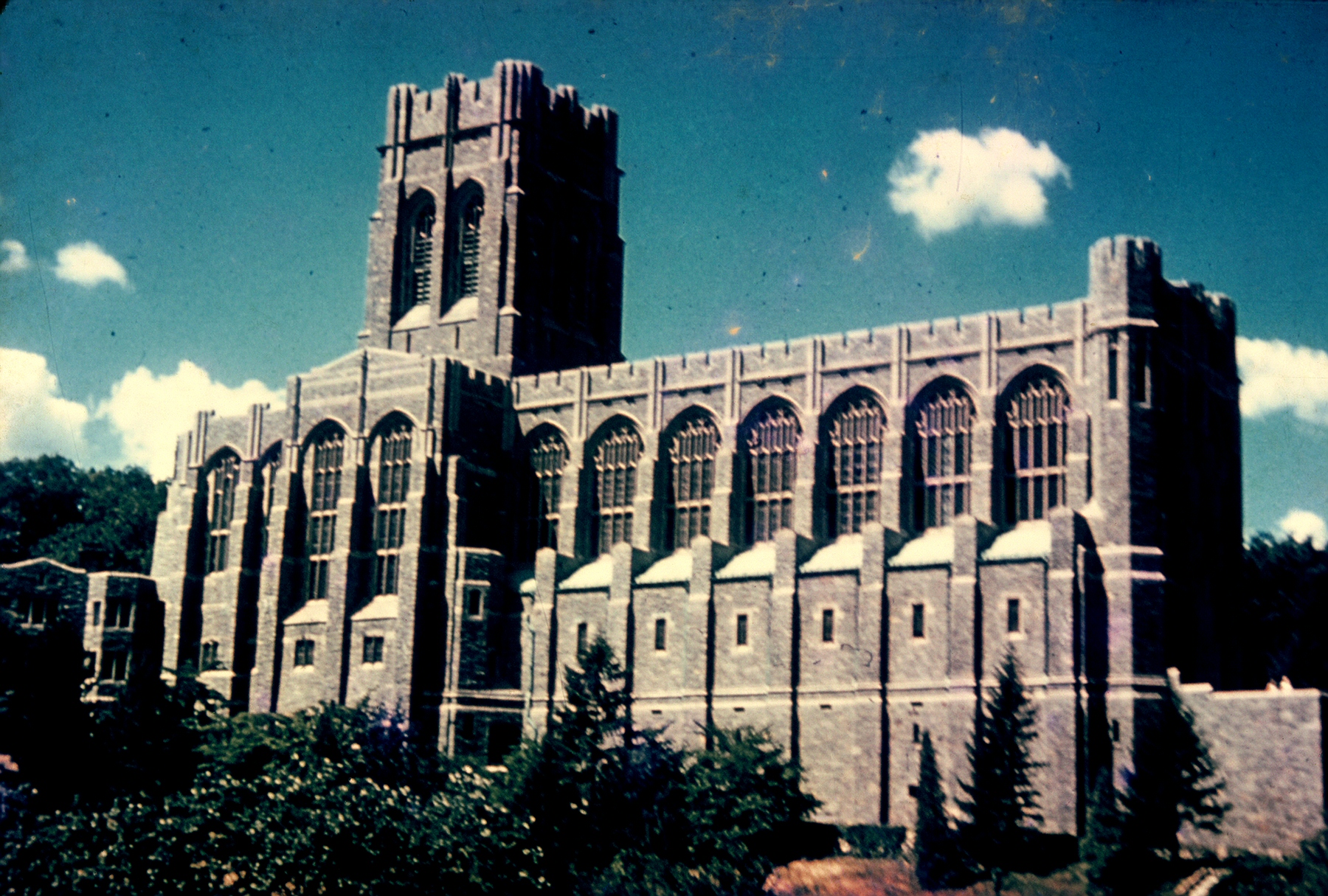 Cadet Chapel Cadet Chapel
 Michie Stadium Michie Stadium
 Arvin Gym Arvin Gym
 Kimsey Athletic Center Kimsey Athletic Center
 Holleder Center Holleder Center
 Washington Monument Washington Monument
 United States Military Academy Band United States Military Academy Band
 Cadet Barracks Cadet Barracks
 Rugby Complex Rugby Complex
 Great Chain Great Chain
 Plain looking toward Washington Hall Plain looking toward Washington Hall
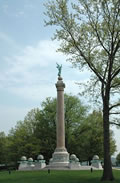 Battle Monument Battle Monument
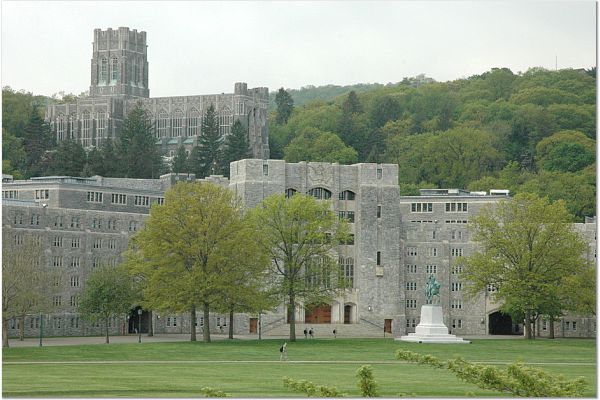 Washington Hall with Cadet Chapel on rocks above. Washington Hall with Cadet Chapel on rocks above.
 Hudson River Hudson River
 Captured Trophies Captured Trophies
 Battle Monument Battle Monument
 West Point Cemetery West Point Cemetery
 Plain Plain
 Cost to this Nation of Differing Views Cost to this Nation of Differing Views
 Trophy Point -- Our Flag Trophy Point -- Our Flag
 Corps of Cadets Formed in Companies early 1960s Corps of Cadets Formed in Companies early 1960s
 Corps of Cadets Formed in Companies early 1960s Corps of Cadets Formed in Companies early 1960s
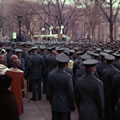 Sending the Army Team off to Beat Navy Sending the Army Team off to Beat Navy
 Army Mule Army Mule
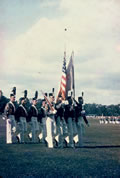 Color Guard Color Guard

Band Box Review Early 1950's in Central Area
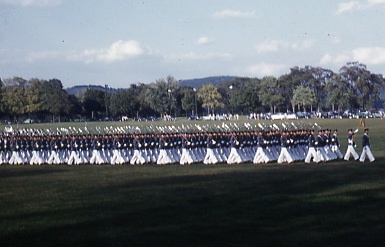 Battalion Mass Early 50's Battalion Mass Early 50's
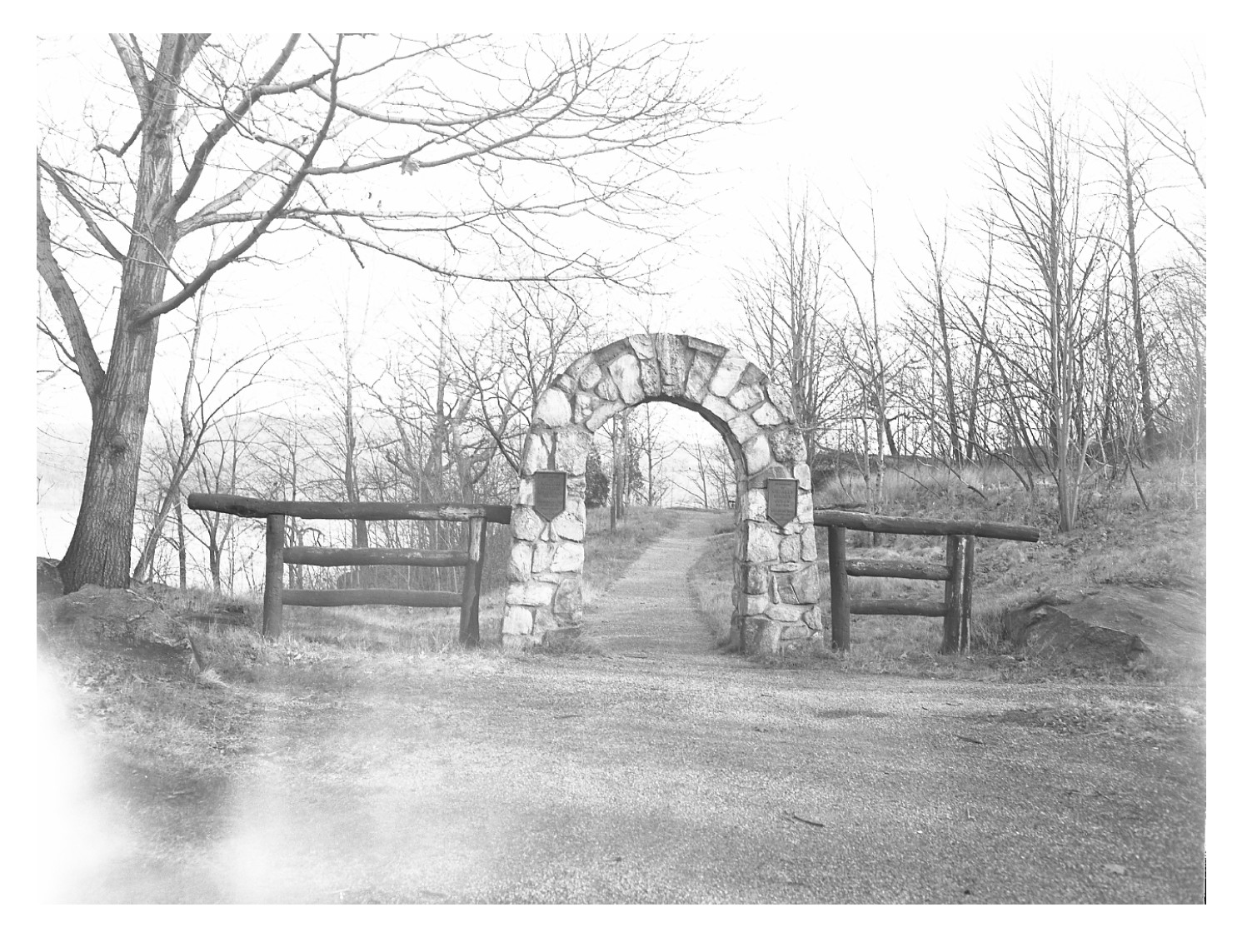 Flirtation Walk Flirtation Walk

 Arvin Gym Arvin Gym
Duty Honor Country
 Cadet will not Lie, Cheat, Steal, or Tolerate Those Who Do Cadet will not Lie, Cheat, Steal, or Tolerate Those Who Do
 Motto -- Duty Honor Country Motto -- Duty Honor Country
 Remember - The Soldiers you will lead Always Come First Remember - The Soldiers you will lead Always Come First

 Academic Excellence Academic Excellence
 --They played perhaps Army's Greatest Game. They were the Team that Gave The Most --They played perhaps Army's Greatest Game. They were the Team that Gave The Most
 Colonel Thayer Colonel Thayer
 West Point mid 60's West Point mid 60's
 Trophy Point Trophy Point
 L'Ecole Polytechnique Monument, or The French Monument by Cadets L'Ecole Polytechnique Monument, or The French Monument by Cadets
 Superintendent's Quarters viewed from Thayer Road Superintendent's Quarters viewed from Thayer Road
 Cadet Chapel Cadet Chapel
 Michie Stadium Michie Stadium
 Arvin Gym Arvin Gym
 Kimsey Athletic Center Kimsey Athletic Center
 Holleder Center Holleder Center
 Washington Monument Washington Monument
 United States Military Academy Band United States Military Academy Band
 Barracks Barracks
 Rugby Complex Rugby Complex
 Great Chain Great Chain
 Plain looking toward Washington Hall Plain looking toward Washington Hall
 Battle Monument Battle Monument
 Washington Hall with Cadet Chapel on rocks above. Washington Hall with Cadet Chapel on rocks above.
 Hudson River Hudson River
 Captured Trophies Captured Trophies
 Battle Monument Battle Monument
 West Point Cemetery West Point Cemetery
 Plain Plain
 Cost to this Nation of Differing Views Cost to this Nation of Differing Views
 Trophy Point -- Our Flag Trophy Point -- Our Flag
 Corps of Cadets Formed in Companies early 1960s Corps of Cadets Formed in Companies early 1960s
 Corps of Cadets Formed in Companies early 1960s Corps of Cadets Formed in Companies early 1960s
 Sending the Army Team off to Beat Navy Sending the Army Team off to Beat Navy
 Army Mule Army Mule
 Color Guard Color Guard

Band Box Review Early 1950's in Central Area
 Battalion Mass Early 50's Battalion Mass Early 50's
 Flirtation Walk Flirtation Walk
 Cadet will not Lie, Cheat, Steal, or Tolerate Those Who Do Cadet will not Lie, Cheat, Steal, or Tolerate Those Who Do
 Motto -- Duty Honor Country Motto -- Duty Honor Country
 Remember - The Soldiers you will lead Always Come First Remember - The Soldiers you will lead Always Come First
 Academic Excellence Academic Excellence
 They played perhaps Army's Greatest Game. They were the Team that Gave The Most They played perhaps Army's Greatest Game. They were the Team that Gave The Most
 Colonel Thayer Colonel Thayer
 West Point mid 60's West Point mid 60's
 Trophy Point Trophy Point
 L'Ecole Polytechnique Monument, or The French Monument by Cadets L'Ecole Polytechnique Monument, or The French Monument by Cadets
 Superintendent's Quarters viewed from Thayer Road Superintendent's Quarters viewed from Thayer Road
 Cadet Chapel Cadet Chapel
 Michie Stadium Michie Stadium
 Arvin Gym Arvin Gym
 Kimsey Athletic Center Kimsey Athletic Center
 Holleder Center Holleder Center
 Washington Monument Washington Monument
 United States Military Academy Band United States Military Academy Band
 Barracks Barracks
 Rugby Complex Rugby Complex
 Great Chain Great Chain
 Plain looking toward Washington Hall Plain looking toward Washington Hall
 Battle Monument Battle Monument
 Washington Hall with Cadet Chapel on rocks above. Washington Hall with Cadet Chapel on rocks above.
 Hudson River Hudson River
 Captured Trophies Captured Trophies
 Battle Monument Battle Monument
 West Point Cemetery West Point Cemetery
 Plain Plain
 - Cost to this Nation of Differing Views - Cost to this Nation of Differing Views
 Trophy Point -- Our Flag Trophy Point -- Our Flag
 Corps of Cadets Formed in Companies early 1960s Corps of Cadets Formed in Companies early 1960s
 Corps of Cadets Formed in Companies early 1960s Corps of Cadets Formed in Companies early 1960s
 Sending the Army Team off to Beat Navy Sending the Army Team off to Beat Navy
 - Army Mule - Army Mule
 Color Guard Color Guard

Band Box Review Early 1950's in Central Area
 Battalion Mass Early 50's Battalion Mass Early 50's
 Flirtation Walk Flirtation Walk
Click on Photos Below
Please note it takes a couple of hours to update all pages as material is added to this section. You may have to return to the home page to see all of the current links
 Cadet will not Lie, Cheat, Steal, or Tolerate Those Who Do Cadet will not Lie, Cheat, Steal, or Tolerate Those Who Do
 We have changed the wording of our Alma Mater to reflect the fact that our Women Graduates have also given their lives serving this Nation.
We have changed the wording of our Alma Mater to reflect the fact that our Women Graduates have also given their lives serving this Nation.
 ----- Class of 2012 Motto ----- "For More Than Ourselves" Thank you Class of 2012 for the Honor of Marching with you
The Class of 62 ----- Class of 2012 Motto ----- "For More Than Ourselves" Thank you Class of 2012 for the Honor of Marching with you
The Class of 62
 ---------- Class of 2008 --------- ----- Class Crest & Motto ----- "No Mission Too Great" ---------- Class of 2008 --------- ----- Class Crest & Motto ----- "No Mission Too Great"
---- Their Commencement ---- "Here am I; Send me." Thank you Class of 2008 and Please Thank the Men & Women --- the Soldiers you will lead ---
The Class of 62.
 Motto -- Duty Honor Country Motto -- Duty Honor Country
 Remember - The Soldiers you will lead Always Come First Remember - The Soldiers you will lead Always Come First
 Jefferson Hall - the Academy's new Library.
Jefferson Hall - the Academy's new Library.
 Academic Excellence Academic Excellence
 --They played perhaps Army's Greatest Game. They were the Team that Gave The Most --They played perhaps Army's Greatest Game. They were the Team that Gave The Most
 ---- Colonel Thayer ---- Colonel Thayer
 West Point mid 60's West Point mid 60's
 Trophy Point Trophy Point
 L'Ecole Polytechnique Monument, or The French Monument by Cadets L'Ecole Polytechnique Monument, or The French Monument by Cadets
 Superintendent's Quarters viewed from Thayer Road Superintendent's Quarters viewed from Thayer Road
 Cadet Chapel Cadet Chapel
 Michie Stadium Michie Stadium
 Arvin Gym Arvin Gym
 Kimsey Athletic Center Kimsey Athletic Center
 Holleder Center Holleder Center
 Washington Monument Washington Monument
 United States Military Academy Band United States Military Academy Band
 Barracks Barracks
 Rugby Complex Rugby Complex
 Great Chain Great Chain
 Plain looking toward Washington Hall Plain looking toward Washington Hall
 Battle Monument Battle Monument
 Washington Hall with Cadet Chapel on rocks above. Washington Hall with Cadet Chapel on rocks above.
 Hudson River Hudson River
 Captured Trophies Captured Trophies
 Battle Monument Battle Monument
 West Point Cemetery West Point Cemetery
 Plain Plain
 - Cost to this Nation of Differing Views - Cost to this Nation of Differing Views
 Trophy Point -- Our Flag Trophy Point -- Our Flag
 Corps of Cadets Formed in Companies early 1960s Corps of Cadets Formed in Companies early 1960s
 Corps of Cadets Formed in Companies early 1960s Corps of Cadets Formed in Companies early 1960s
 Sending the Army Team off to Beat Navy Sending the Army Team off to Beat Navy
 - Army Mule - Army Mule
 Color Guard Color Guard

Band Box Review Early 1950's in Central Area
 Battalion Mass Early 50's Battalion Mass Early 50's
 Flirtation Walk Flirtation Walk

 Arvin Gym Arvin Gym
Duty Honor Country
 Cadet will not Lie, Cheat, Steal, or Tolerate Those Who Do Cadet will not Lie, Cheat, Steal, or Tolerate Those Who Do
 Motto -- Duty Honor Country Motto -- Duty Honor Country
 Remember - The Soldiers you will lead Always Come First Remember - The Soldiers you will lead Always Come First

 Academic Excellence Academic Excellence
 --They played perhaps Army's Greatest Game. They were the Team that Gave The Most --They played perhaps Army's Greatest Game. They were the Team that Gave The Most
 ---- Colonel Thayer ---- Colonel Thayer
 West Point mid 60's West Point mid 60's
 Trophy Point Trophy Point
 L'Ecole Polytechnique Monument, or The French Monument by Cadets L'Ecole Polytechnique Monument, or The French Monument by Cadets
 Superintendent's Quarters viewed from Thayer Road Superintendent's Quarters viewed from Thayer Road
 Cadet Chapel Cadet Chapel
 Michie Stadium Michie Stadium
 Arvin Gym Arvin Gym
 Kimsey Athletic Center Kimsey Athletic Center
 Holleder Center Holleder Center
 Washington Monument Washington Monument
 United States Military Academy Band United States Military Academy Band
 Barracks Barracks
 Rugby Complex Rugby Complex
 Great Chain Great Chain
 Plain looking toward Washington Hall Plain looking toward Washington Hall
 Battle Monument Battle Monument
 Washington Hall with Cadet Chapel on rocks above. Washington Hall with Cadet Chapel on rocks above.
 Hudson River Hudson River
 Captured Trophies Captured Trophies
 Battle Monument Battle Monument
 West Point Cemetery West Point Cemetery
 Plain Plain
 - Cost to this Nation of Differing Views - Cost to this Nation of Differing Views
 Trophy Point -- Our Flag Trophy Point -- Our Flag
 Corps of Cadets Formed in Companies early 1960s Corps of Cadets Formed in Companies early 1960s
 Corps of Cadets Formed in Companies early 1960s Corps of Cadets Formed in Companies early 1960s
 Sending the Army Team off to Beat Navy Sending the Army Team off to Beat Navy
 - Army Mule - Army Mule
 Color Guard Color Guard

Band Box Review Early 1950's in Central Area
 Battalion Mass Early 50's Battalion Mass Early 50's
 Flirtation Walk Flirtation Walk
 Cadet will not Lie, Cheat, Steal, or Tolerate Those Who Do Cadet will not Lie, Cheat, Steal, or Tolerate Those Who Do
 Motto -- Duty Honor Country Motto -- Duty Honor Country
 Remember - The Soldiers you will lead Always Come First Remember - The Soldiers you will lead Always Come First
 Academic Excellence Academic Excellence
 --They played perhaps Army's Greatest Game. They were the Team that Gave The Most --They played perhaps Army's Greatest Game. They were the Team that Gave The Most
 ---- Colonel Thayer ---- Colonel Thayer
 West Point mid 60's West Point mid 60's
 Trophy Point Trophy Point
 L'Ecole Polytechnique Monument, or The French Monument by Cadets L'Ecole Polytechnique Monument, or The French Monument by Cadets
 Superintendent's Quarters viewed from Thayer Road Superintendent's Quarters viewed from Thayer Road
 Cadet Chapel Cadet Chapel
 Michie Stadium Michie Stadium
 Arvin Gym Arvin Gym
 Kimsey Athletic Center Kimsey Athletic Center
 Holleder Center Holleder Center
 Washington Monument Washington Monument
The material below this point is a site a work area.


Page 2
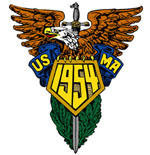 The '54 Crest
The '54 Crest
 General MacArthur stated it would take
General MacArthur stated it would take "at least 10 years" to return Army Football to Respectability
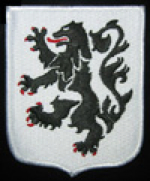 28th Infantry Regiment Black Lion Award is intended to go to the person on his team "who best exemplifies the character of Don Holleder: leadership, courage, devotion to duty, self-sacrifice, and - above all -
28th Infantry Regiment Black Lion Award is intended to go to the person on his team "who best exemplifies the character of Don Holleder: leadership, courage, devotion to duty, self-sacrifice, and - above all - an unselfish concern for the team ahead of himself."
 General George Patton
General George Patton "The Army moves as a team, eats as a team, and fights as a team."
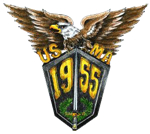 The '55 Crest
The '55 Crest
 They played perhaps Army's Greatest Game. They played perhaps Army's Greatest Game.They were the Team that Gave The Most
 Don Hollender Remember - The Soldiers you will lead Always Come First
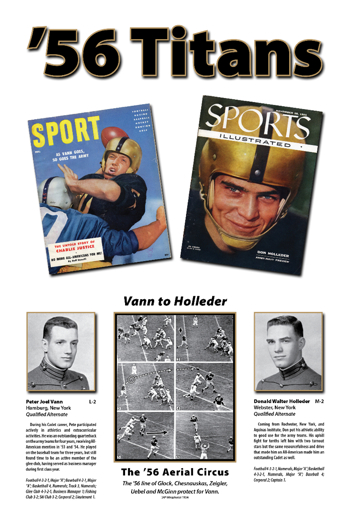 Vann and Holleder Vann and Holleder
 9 Army A's 9 Army A's
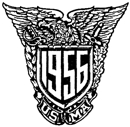 The '56 Crest
The '56 Crest
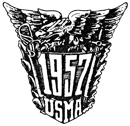 The '57 Crest
The '57 Crest
 Can Do
Can Do
 Gen Van Fleet addressing the Corps prior to the Navy Game
Gen Van Fleet addressing the Corps prior to the Navy Game
 Constructed under supervision of Jay Gould "54 and the Ord Dept from a German Rocket Gun captured at Kasserine Pass. First used in the Duke Game.
Constructed under supervision of Jay Gould "54 and the Ord Dept from a German Rocket Gun captured at Kasserine Pass. First used in the Duke Game.
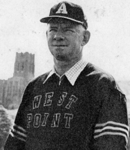 COL "Red" Reeder granted the Cheerleaders Corps Squad status to obtain financial support for their spirit-inducing initiatives.
COL "Red" Reeder granted the Cheerleaders Corps Squad status to obtain financial support for their spirit-inducing initiatives.
 Bob Mischak - - It should be pointed out that Bob was an All American selection, but is not recognized by the Academy as such because of the organization which selected him. Bob Mischak - - It should be pointed out that Bob was an All American selection, but is not recognized by the Academy as such because of the organization which selected him.
 Ubel scores 3 Times against Navy - Vann's facking results in Peter getting tackled - #10 on the ground behind Ubel
Ubel scores 3 Times against Navy - Vann's facking results in Peter getting tackled - #10 on the ground behind Ubel
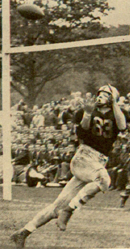 Vann to Sisson
Vann to Sisson
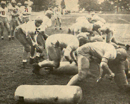 Army's B Squad
Army's B Squad
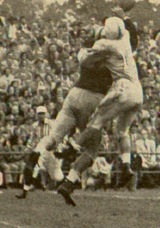 Vann to Mischak. Vann to Mischak.
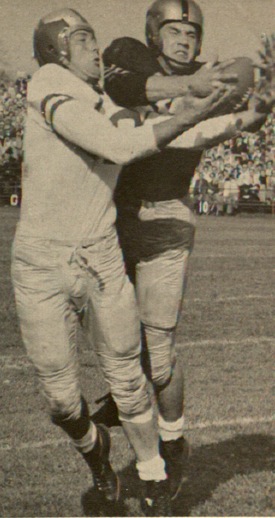 Uebel Intercepts Uebel Intercepts
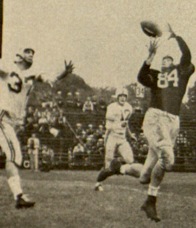 Cody to Don Holleder Cody to Don Holleder
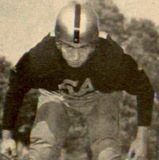 Lasley Lasley
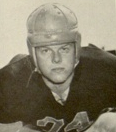 Frank Hicks Frank Hicks
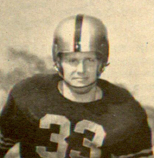 Burd Burd
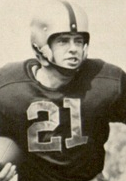 Bill Purdue Bill Purdue
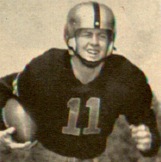 Cody Cody
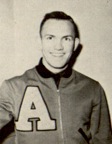 Meador Mgr Meador Mgr
 Ron Melnick Ron Melnick
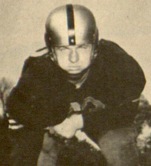 Ralph Chesnauskas Ralph Chesnauskas
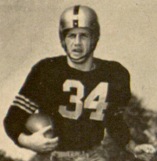 Pat Uebel Pat Uebel
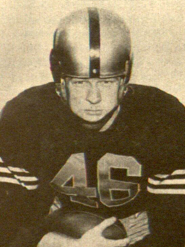 Tommy Bell Tommy Bell
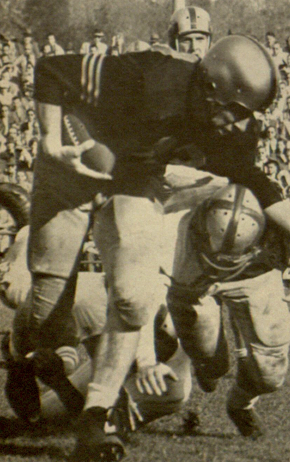 Sisson headed for another score Sisson headed for another score
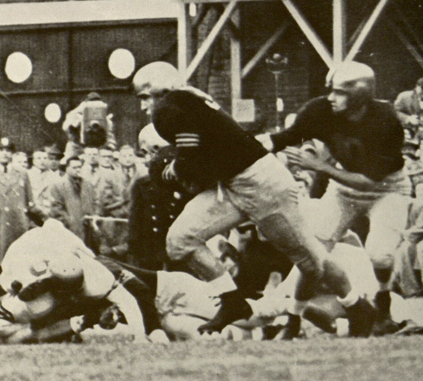 Peter Vann stuffs the ball in Jerry's gut Peter Vann stuffs the ball in Jerry's gut
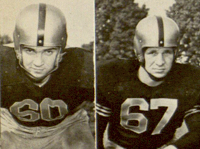 Leroy Lunn & Jerry Lodge Leroy Lunn & Jerry Lodge
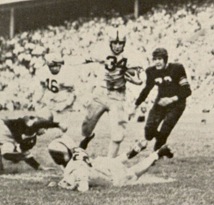 Uebel after taking the handoff from Hagan
Uebel after taking the handoff from Hagan
 Attaya - Army's Fullback
Attaya - Army's Fullback
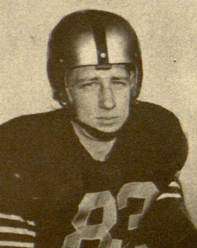 Sisson - one of 3 Great Ends
Sisson - one of 3 Great Ends
 Bob Mischak Bob Mischak
 Unknown Unknown
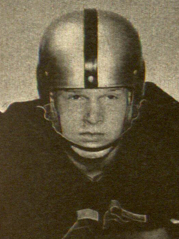 Unknown Unknown
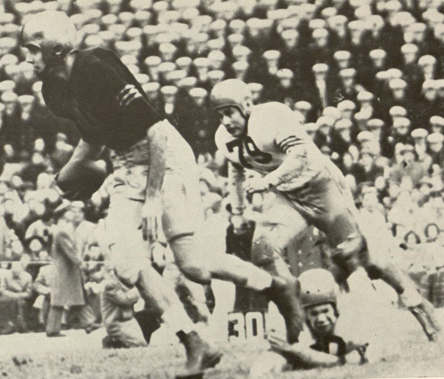 Vann moving out of the pocket
Vann moving out of the pocket
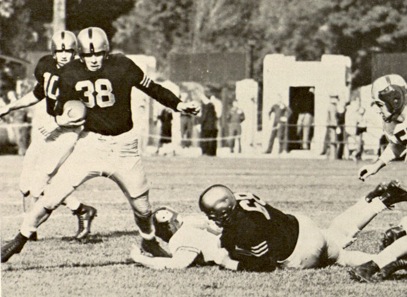 Peter Vann 10, Billy Chance 38, Herdman 68
Peter Vann 10, Billy Chance 38, Herdman 68
 Ken Kramer Ken Kramer
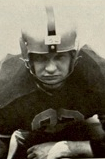 Joe Lapchick Joe Lapchick
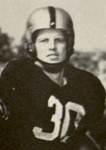 Kirk Cockrell Kirk Cockrell
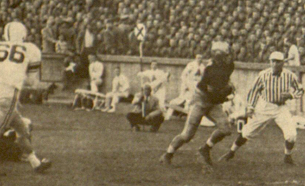 Lodge going down tosses to Paul Schweikert for score. Lodge going down tosses to Paul Schweikert for score.
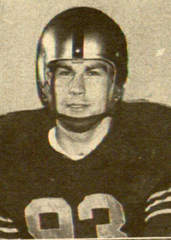 Unknown Unknown
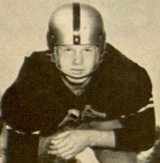 Bob FarrisPlayed the 2d half of the Navy Game blind in one eye. Bob FarrisPlayed the 2d half of the Navy Game blind in one eye.
 Pat Uebel Pat Uebel
 Tommy Bell Tommy Bell
 Peter Vann Peter Vann
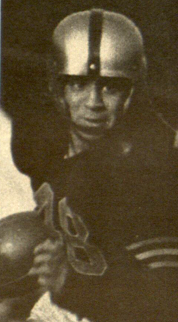 Freddie Attaya Freddie Attaya
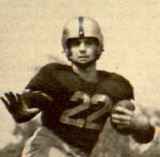 Mike Zeigler Mike Zeigler
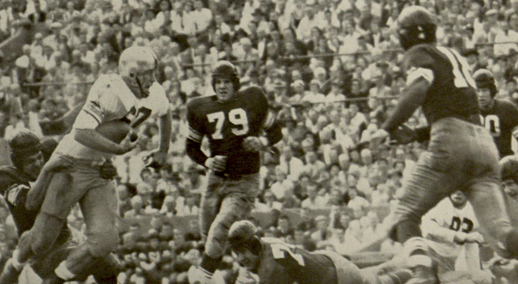 Jerry Lodge wearing #67, playing fullback. Jerry Lodge wearing #67, playing fullback.
 Wynn Wynn
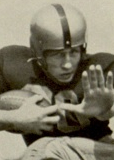 Lowell Sisson Lowell Sisson
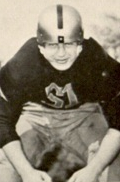 Norm Stephen Norm Stephen
 Jack Krause Jack Krause
 Dick Ziegler Dick Ziegler
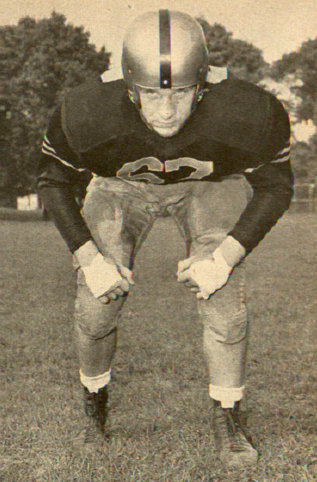 Jerry Lodge Jerry Lodge
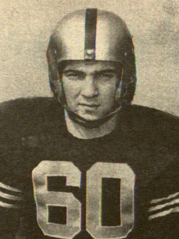 Leroy Lunn Leroy Lunn
 Norm Stephen Norm Stephen
 Jerry Lodge Jerry Lodge
 Corps of Cadets for Navy Game Corps of Cadets for Navy Game
 Can Do
Can Do
 General MacArthur stated it would take
General MacArthur stated it would take "at least 10 years" to return Army Football to Respectability
 General George Patton
General George Patton "The Army moves as a team, eats as a team, and fights as a team."
 Don Hollender Remember - The Soldiers you will lead Always Come First
 The '54 Crest
The '54 Crest
 The '55 Crest
The '55 Crest
 28th Infantry Regiment Black Lion Award is intended to go to the person on his team "who best exemplifies the character of Don Holleder: leadership, courage, devotion to duty, self-sacrifice, and - above all -
28th Infantry Regiment Black Lion Award is intended to go to the person on his team "who best exemplifies the character of Don Holleder: leadership, courage, devotion to duty, self-sacrifice, and - above all - an unselfish concern for the team ahead of himself."
 They played perhaps Army's Greatest Game. They played perhaps Army's Greatest Game.They were the Team that Gave The Most
 The '56 Crest
The '56 Crest
 The '57 Crest
The '57 Crest
|
1953 Football Team Nomination - pages 2 - ??
Please go to the below page to review the Submitted Nomination
http://forwhattheygaveonsaturdayafternoon.com/wp-53/nom-team
A great deal of work is required before this is ready for submittal
Col. Earl Blaik (Selected as Football Coach of the Year) leaving the field late afternoon Nov. 28th 1953 after the Army Team beat Navy 20 to 7. Army Football Classics - 1953 Football Film - - - - - http://forwhattheygaveonsaturdayafternoon.com/wp-1954/army-navy53
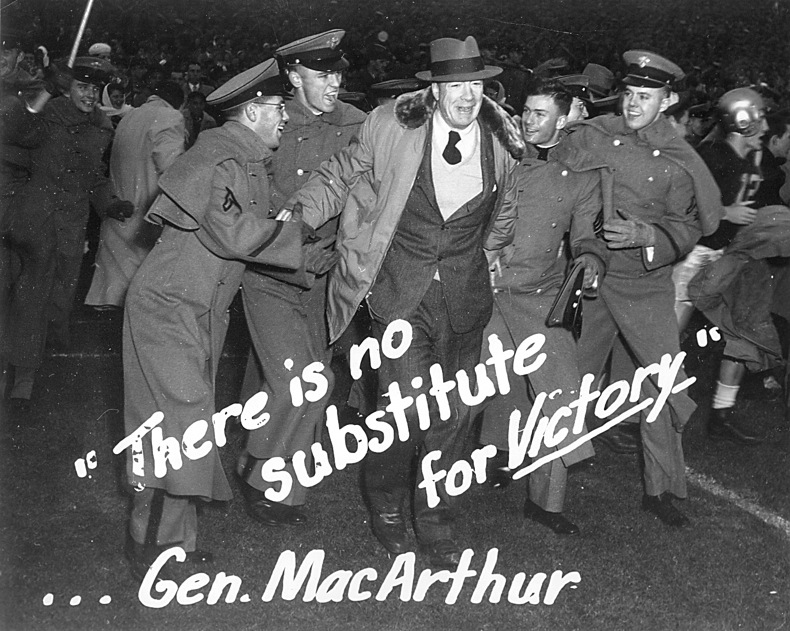 Cadets left to right, Clyde W. La Grone, Roman J. Peisinger, Ira Coron, and Leonard Griggs. In the background is Rox Shain, the Army player whose game-opening diagonal kickoff preceded Navy's fumble. (Photo courtesy of Willis C. Tomsen, '54.) Cadets left to right, Clyde W. La Grone, Roman J. Peisinger, Ira Coron, and Leonard Griggs. In the background is Rox Shain, the Army player whose game-opening diagonal kickoff preceded Navy's fumble. (Photo courtesy of Willis C. Tomsen, '54.) "I have never coached a team that give me more than you did. I never have coached a team that has given me as much satisfaction. Considering all the conditions since 1951, you have done more for football at West Point than any other team in the history of the Academy."
Every Cadet Athlete - no every Cadet should know what this Team did - what they did for West Point, for our Motto.
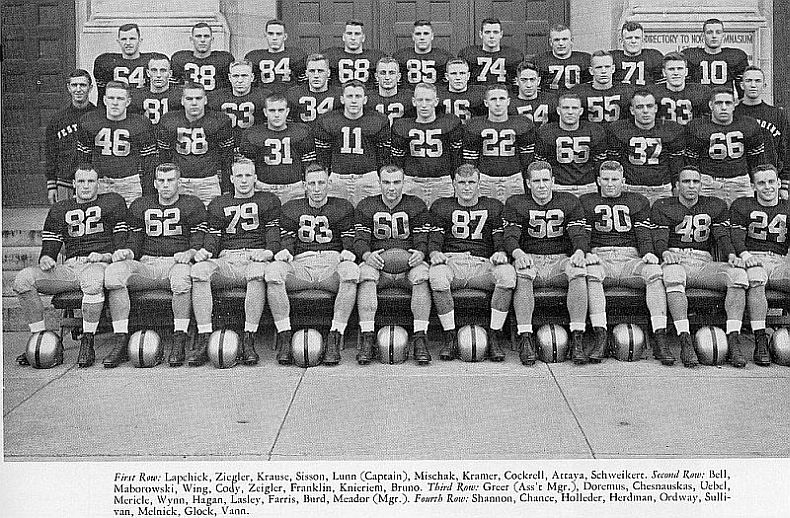 Please note - Jerry Lodge - who wore #67 and #32 is missing from Photo as is Norm Stephen #51- Army Center. 2d man 2d row next to Tommy Bell - Name is Zaborowski. Wynn #31 is actually in the 2d row not the 3d
Please note - Jerry Lodge - who wore #67 and #32 is missing from Photo as is Norm Stephen #51- Army Center. 2d man 2d row next to Tommy Bell - Name is Zaborowski. Wynn #31 is actually in the 2d row not the 3d
When I come to describe the team of 1953, what they meant to me and, far more important, what they meant to West Point, I cannot praise them enough."
Of them, Grantland Rice wrote with eloquent simplicity, "They came up the hard way and there probably has never been a squad with a finer spirit."
To understand the magnitude of the accomplishments of this team, recall that General McArthur gave his opinion in 1951 that it would take 10 years for Army to recover and field a top tier team. It took two years.
Coach Earl Blaik: "Injuries as the season advanced cost the team solid fullback and punter, three-year letterman Fred Attaya '54; hard-nosed right halfback and three-year letterman Mike Zeigler '56; and spirited end and three-year letterman "Ski" Godwin Ordway '55. By the time the season got down to the Penn and Navy games, the starting eleven and about four substitutes carried the full load."
In 1950, Army was 8-1 with a victory over Stanford, which finished the season ranked number seven in the nation; was tops in the nation in scoring defense, fourth in total defense, ninth in passing defense, and 10th in rushing offense; featured an All-American at end who finished eighth in the Heisman Trophy balloting, and two tackles who received votes for first team All-American; and would have been undefeated except for the stunning upset at the hands of Navy.
In 1951, Army went 2-7, defeating only Columbia and The Citadel and was trounced by Navy. Only one player received any national recognition, a name eventually to be etched in the hearts of all Army fans for decades to come: Mischak '54 was number five in total kickoff return yards and first in average yards returned. The 1952 season was better, Army going 4-4, defeating South Carolina, but losing to Navy.
True, the Corps of Cadets did look for better things than in 1951 and "52". Any prognostication that Army would win the Lambert Trophy, emblematic of the Eastern Championship, and be rated No. 14 nationally would have been tabbed fantastic. With Coach Blaik's words as background, the team's history echoes his witness.
They were one of the smallest Army football teams in years, at season's end thirty-eight men, a team of heroes with no stars and with a different hero each Saturday, all playing for honor and love of the game. They were led by quiet, solid leaders from the class of 1954; augmented by a small number of players from the smallest Academy class in years, 1955, and a bevy of talented yearlings in the class of 1956 who set the gridiron on fire that fall. The NCAA changed the rules for the 1953 season to what is now called "one platoon" football, really "iron man" football.
Though the phrase wasn't originated by Coach Earl Blaik, it was the incomparable football teacher, the thoroughly emotionally-controlled Blaik who, with tears in his eyes, handed the Army-Duke game ball to Bob Mischak, Army's left end who made the incredible game-saving tackle. Blaik's words to Bob were simple but powerful, and echo down through the years,
- - - - - - - - - - - - - - - "Don't ever give up." - - - - - - - - - - - - - - -
|

Mischak leaping on Duke's All American Red Smith after the 73 yard run down, Army held taking over inches from the goal line. Col Blaik ordered an immediate punt and Army again held Duke at bay. It must be pointed out that Bob was the only player on the '53 Team to be selected as an All American. Today the Academy does not recognze his All American status because of the organization which selected him.
Army Football Classics - 1953 Football Film
http://forwhattheygaveonsaturdayafternoon.com/wp-1954/army-duke-1953 |
The cheating incident had never-publicized, lingering effects on Army football players in the three following seasons, effects witnessed and painfully felt by the young, inexperienced B and C teams - the men who accomplished the "football miracle" of 1953.
As Blaik wrote years later in baring his bitterness and frustration over the cheating incident, "For two years these boys had seen the roughest action. They had lived with the coaching lash, dirt, blood, and defeat."
Adding to the effects the players faced was the revelation that the much-admired Army varsity had been deeply involved in what became a national scandal.
In a number of cases the players left to pick up the pieces became subjects of totally unwarranted suspicions and stinging criticisms simply because they were Army football players. The season of 1953 changed all that -- the team and the Corps of Cadets washed the effects away with stunning, inspirational teamwork and marvelous achievements. Yet, there were more hurdles to cross before they could accomplish their football miracle.
Following the 1952 season, changes in National Collegiate Athletic Association (NCAA) rules greatly restricted substitution and for several years virtually ended the offensive-defensive unit two-platoon system. The result was to lengthen playing
|
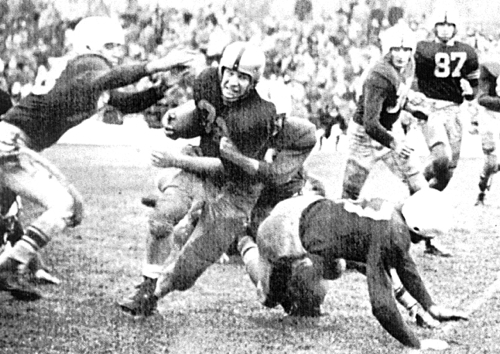
Lodge shifted to Fullback - turning the corner, Mischak 87.
|
time for varsity players, decrease the number of varsity letters awarded, increase injury potential, and cause a return to what in years past had been called "iron man football". To compete under the more complicated substitution rules, Coach Blaik chose to return to the type of two-platoon system he inaugurated at Army during the World War II years, two or three units that went both ways, on offense and defense.
While the rule changes impacted all collegiate teams, no team Army was to face in 1953 had suffered the total loss of its varsity lettermen and team leaders two years earlier. The losses had forced virtually complete rebuilding from the ground up. Other colleges and universities would have been able to accelerate efforts to make up such losses with much larger student bodies and massive numbers of alumni on the lookout for talent, aggressive well-funded recruiting, junior college transfers, and the growing lure of expanding professional football immediately after graduation. Not so at Army.
|
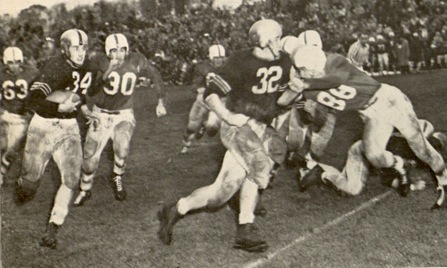
Pat with the ball -- There appears to be a guard on the other side of Lodge blocking 88 -- is this play later to become known as the Green Bay Power Sweep?
|
The NCAA rule changes had other impacts not normally visible to cadets and Army sports fans -- but were quite clear to team members vying for varsity status and the coveted Major A. The remaining 1953 team members, who, at the end of the 1952 season believed they had almost secured starting offensive or defensive platoon positions, suddenly found themselves being retested and moved from one position to another to determine who could play both offense and defense and had the conditioning, strength and stamina to play both ways.
Their extraordinary individual responses were inspirational, highlighting individual willingness to sacrifice for the team.
Bob Farris played the entire second half of the Navy game totally blind in one eye. Although he was captain of the '54 team, he was never to play another down of football.
Again, from Col Blaik's '74 book.
"A normal amount of injuries as the season advanced cost us solid fullback and punter "Fred Attaya", hard-nosed right halfback "Mike Zeigler", spirited end "Ski" "Godwin Ordway", and a few others."
"By the time we got down to the Penn and Navy games, the starting eleven and about four substitutes carried the full load."
Some of the Season ending Injuries
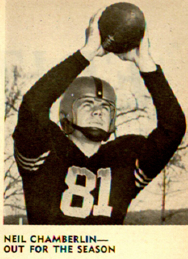
|
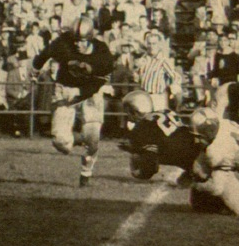 Zeigler # 22 - 14 Yards, Burd coming across to Block. Zeigler # 22 - 14 Yards, Burd coming across to Block.
|
 "Ski" Ordway "Ski" Ordway
|
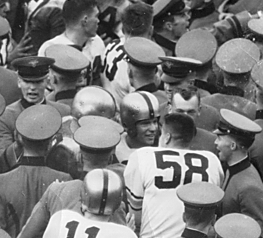 Franklin - season over - double team tore up knee but a smile talking with 58 Zaborowski after Duke Game Franklin - season over - double team tore up knee but a smile talking with 58 Zaborowski after Duke Game
|
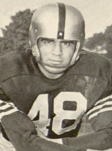 Attaya Army's Fullback Attaya Army's Fullback
|
Neil Chamberlain injured summer of '53 said this prior to the Navy Game. "Saturday Army will be represented by two different uniforms - - one black and gold, the other gray. I've found that I fight just as hard in one as I did in the other. We'll all beat Navy this year."
 Vann to Holleder Vince Lombardi's uncompromising demands on Vann, resulted in Peter becoming a superb drop back passer; with great ball-handling ability whose faking repeatedly confused defensive linemen. He was to set numerous Academy Records while the success Vince Lumbardi achieved as an Assistant Coach under Col Blaik propelled him to success in the Pros. Vann to Holleder Vince Lombardi's uncompromising demands on Vann, resulted in Peter becoming a superb drop back passer; with great ball-handling ability whose faking repeatedly confused defensive linemen. He was to set numerous Academy Records while the success Vince Lumbardi achieved as an Assistant Coach under Col Blaik propelled him to success in the Pros.
|
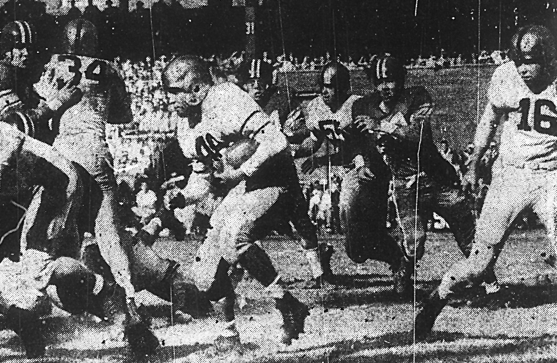 Hagan's handoff to Attaya initial scoring drive against Duke. Uebel #34 and probably #55 - Farris. NY Times Hagan's handoff to Attaya initial scoring drive against Duke. Uebel #34 and probably #55 - Farris. NY Times
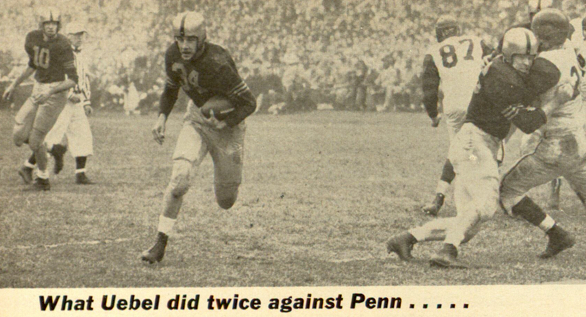 Number #10's faking holds the defensive line in place allowing dominance by the offensive lineman for the wide open end run by Pat.
|
At quarterback, Peter Vann shared the job to some extent with Jerry Hagan early in the season, but improved gradually to indispensable level.
Vann, Pat Uebel, and Tommy Bell at halfbacks and Gerry Lodge at fullback played 60 minutes against Penn and almost all the way in the Navy game.
It's important to note, that Peter Vann was a sterling offensive team leader his last two years at Army, became a classic drop-back passer and deft ball-handling and faking wizard who repeatedly confused defensive linemen, and was far more than Blaik's description of him on defense as "dependable in a crisis". Playing at defensive right halfback on the last play of the season's crucial, turnaround game, he too made a game-saving play, batting away a pass thrown from Duke's quarterback to their alternate quarterback -- in the Army end zone - then went on to be ninth in Heisman Trophy voting and a second team All-American quarterback in 1954.
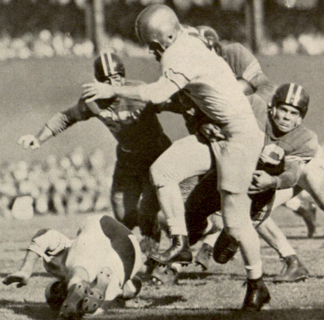 Tommy Bell against Duke Tommy Bell against Duke
|

Vann to Mischak. The only way to stop the catch is to climb on top prior to the arrival of the ball.
|
Right halfback Tommy Bell, scored one of the two touchdowns against Duke, became a first team All-American in 1954 and that same year one of the few four-year lettermen in Army football history. Yearling left halfback Pat Uebel, who scored one of the two touchdowns in the stunning upset of No. 7-ranked Duke and all three of Army's touchdowns in the win over Navy -- one of a small number of Army players to score three touchdowns against Navy, and to that time the only player to score all three touchdowns in a win over Navy - was another hero in the 1953 Army backfield. Of Army's two lead halfbacks Coach Blaik would write,
"In '53 and '54 both Uebel and Bell were among the top echelon of all-time West Point halfbacks."
Rounding out the backfield after the loss to injury in the Tulane game of the swift, agile, hard-driving fullback, and punter, "Freddie Attaya", was guard-converted-to-fullback Gerry Lodge, who stepped into Freddie's shoes and performed
|

Attaya 46 and Uebel 34 showing 7th ranked Duke how Army played Football
|
magnificently at both fullback on offense and linebacker on defense. It was this backfield, plus three great Army ends, and this team that brought Vince Lombardi to the attention of the New York Giants at the end of the 1953 season, setting Vince on course to become a legendary professional coach.
Blaik said of the three ends on the 1953 team, "Our end play was handled by Bob Mischak, Lowell Sisson, and a yearling of unusual potential named Don Holleder. Sisson was another who kept improving and hit the top in the Navy game. After Attaya's injury, Sisson did the punting.
Mischak developed into a fine pass receiver and on defense he delivered the play that was the pivot, in a real sense, of the entire season. Holleder was a naturally talented pass receiver with outstanding speed, hands, and competitive fire. By 1954 he became just about the most dangerous offensive end in college ranks. Don later became an Army legend in his own right. A first team All-American end in 1954, he voluntarily gave up the chance to become a two-time All-American, by acquiescing to Coach Blaik's request that he switch to quarterback for the 1955 season, a position he had never played in either high school or college. On 17 October 1967, his courage and heroism in Vietnam while attempting to rescue wounded soldiers in his unit cost him his life.
Don Holleder's is life and service became the inspiration for the now-well-known Black Lion Award to football players at every level of football played in the nation, from youth leagues to intercollegiate Division IA.
Army linemen on the thinly-manned 1953 team included three guards, captain Leroy Lunn, his classmate Dick Ziegler, and yearling Ralph Chesnauskas, whose talents included extra-point conversions. Ralph calmly kicked the two extra points against Duke to win the game, and became a first team All-American in 1954.
|
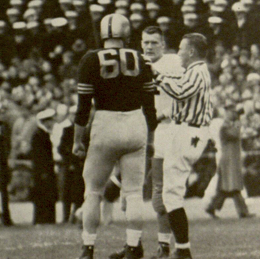
Lunn for the coin toss - here he stayed on the field playing his greatest Game against Navy.
|
Blaik, writing of "Leroy Lunn", said, "I think it epitomized the character of this team and Lunn's inspirational leadership that he was able to handle a difficult situation in a manner that increased his stature. It was not an easy thing to walk out there every Saturday for the toss of the coin and then to have to return to the bench and not be in for the kick-off. Roy never let this bother his playing when he did get in. He improved so much that he clearly earned the right to start with his team against Navy. Then he went out and played the best game of his career."
Center "Norman Stephen" was a steady, rock-solid team leader on offense, who on the first play from scrimmage in the second half of the second home game of the season, against Dartmouth, -- lit a small but growing fire in the team and Corps of Cadets -- when he broke from the huddle and ran, almost sprinting to the ball, prompting the team to follow his lead. The roar of approval and support from the Corps each time Norm broke and ran to the ball, from that point forward through the rest of the season, continued to unify a determined Corps of Cadets with their team. He was a standout linebacker who was the on-field captain who called defensive signals. Starting at tackle were two yearlings, "Ron Melnik" and Howard Glock, with first classman Joe Lapchick, Jr. doing most of the reserve playing.
Coach Blaik considered the heart of his defense to be yearling Bob Farris, a top man academically who in 1955 became the Corps' First Captain, played tackle on offense and was a line backer on defense in 1953. "The linebacking of Farris against Navy was as fine as I have ever seen in that game," he wrote. "Unfortunately, the abandon with which he played cost him a detached retina that ended his football. To have played him would have risked an aggravation that might have impaired his sight. Nevertheless, Bob captained the 54 team and helped out with coaching."
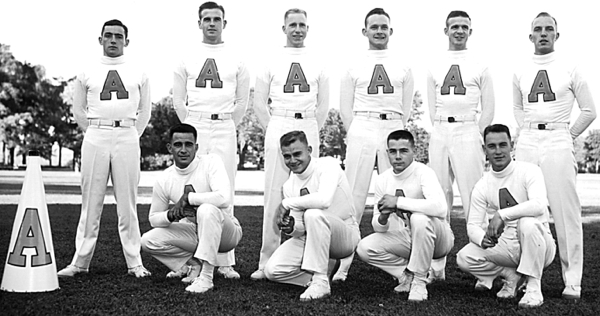
The 1953 cheerleaders, standing, for the Army team, with tumblers inthe first row. Cheerleaders, left to right: Ed Moses, '54; John Clayton '55, Al Worden '55, Billy McVeigh '54, Jay Edwards '54, Bill Robinson '55; Tumblers: Peter Jones '54, Dan Ludwig '55, Jack Charles '54, Charles Glenn '56.
None of the foregoing tells of the incredible will-to-win spirit and support of the 1953 team by the entire Corps of Cadets, all of it specifically intended to unify the team and Corps of Cadets in ways never before seen or heard at West Point.The Corps' preparation for the game had been more than unusual, including a "silence" imposed by the cheerleaders at the meal following Blaik's talk. The "silence" which began after the traditional pregame sendoff of the team - proved potent. The cheerleaders had put a cork in the bottle of more than two years of pent up frustration. When the Corps completed its subdued, strangely silent, pregame march-on at the Polo Grounds, and the last man double-timed onto the first step of the stands, the men in gray exploded out.
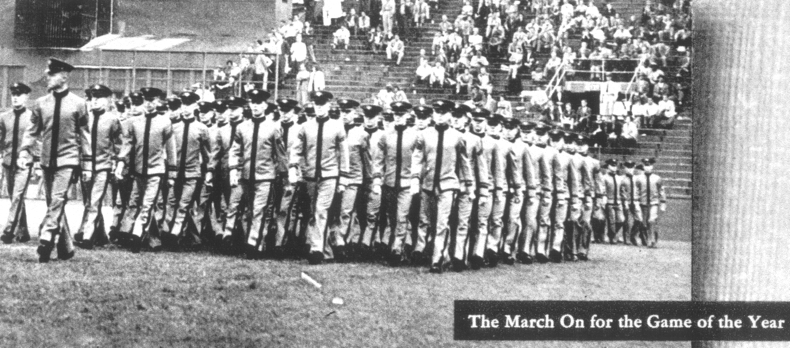
Corps March On, pre-game at the Polo Grounds, 17 October 1953. Jerry Hagan who engineered the 1st touchdown against Duke in recalling the game nearly 56 years later remembers the Chanting. "It was continuous, just deafening".
They shook that old stadium almost non-stop in the sunshine and shadows of that Indian summer afternoon.

The Cannon was constructed from a German Rocket Gun captured at Kasserine Pass. It was first used in the Duke Game. It is shown here at Michie.
This was also the game in which a band of enterprising 1954 and 1955 cheerleaders first rolled out and fired the now-traditional Army victory cannon. The first blast of the cannon culminated months of planning and scheming, in which the cheerleaders prevailed upon COL "Red" Reeder, the Graduate Manager of Athletics, to grant them Corps Squad status to obtain financial support for their spirit-inducing initiatives.
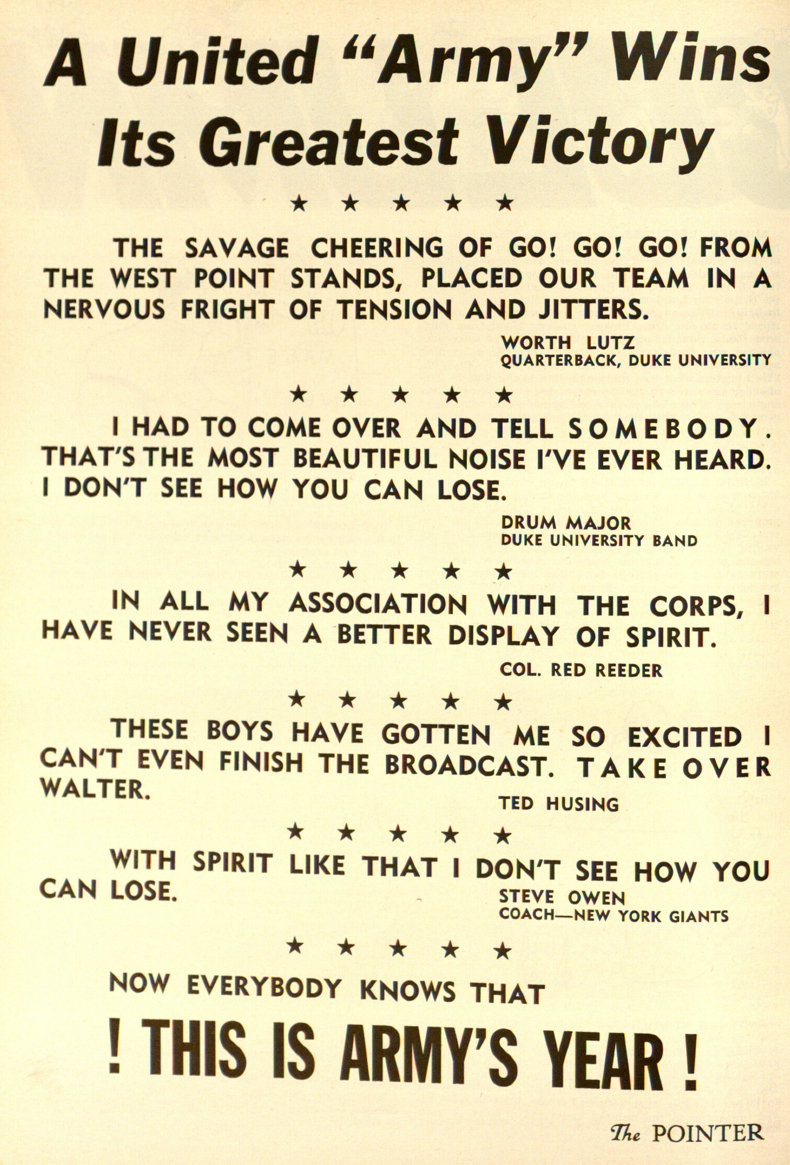
The Spirit of the Corps of Cadets, The Academy Staff and Faculty, and the United States Army after the Duke Game
The Navy Game - November 28, 1953
 Ben Schemmer with Goat and Al Rupp '55 borrowed Billy XII for a couple of days
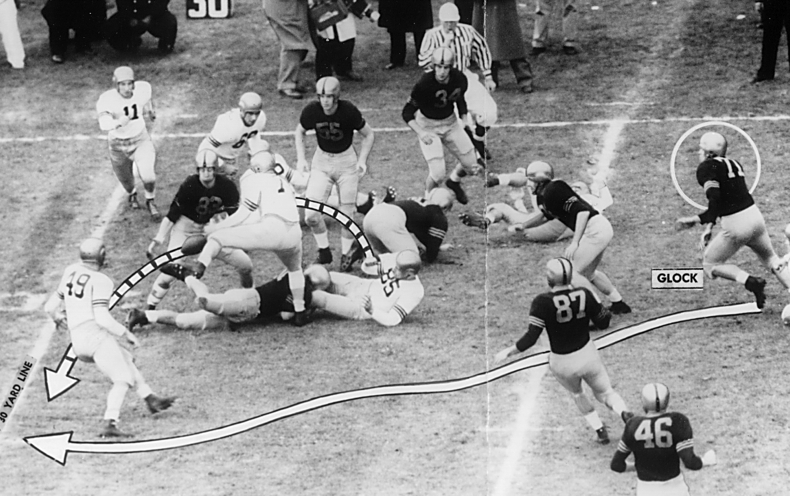 Rox Shain, did not make the trip with the Team but was yanked off the Cadet Train when it arrived early in the morning, kicked off to start the Game. Navy immediately fumbled when Norm Stephen (51)slams the Navy receiver to the ground. The photo (taken by a photographer for the Philadelphia Inquirer) incorrectly identified the Army player recovering the ball, as Howard Glock, when in fact it was Lowell Sisson (83) who is on his feet facing the camera lens as the ball squirts past his thighs. Glock (71), Bell (46), Mischak (87), Farris (55) and Uebel (34) are identifiable. (Photo courtesy of Urban Archives, Temple University, Philadelphia, PA.)

Army's Tommy Bell takes a handoff from Peter Vann. Sisson #83, and probably Uebel #34 bottom center, while it is probably Mischak #87 is on the end of the line
(Photo courtesy of Urban Archives, Temple University, Phildelphia, PA.)

Tommy Bell prepares to take a pass thrown by Peter Vann. From left to right, Lowell Sisson (83), Jerry Lodge on the ground (32), Pat Uebel (34), Howard Glock (71), Leroy Lunn (60), and Norm Stephen (51).
(Photo courtesy of Urban Archives, Temple University, Philadelphia, PA.)
 Uebel scores 3 Times Against Navy Uebel scores 3 Times Against Navy
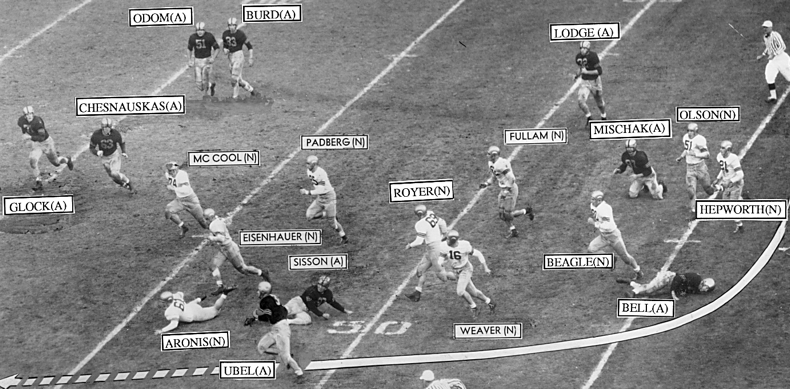
Pat Uebel races for the end zone, running back a Navy punt for a
touchdown. There are some errors in identification of the Army
players. In the upper left, Odom is in fact Norm Stepen (51), Burda
is in fact Lowell Sisson (83), and the numbers of the player
identified as Sisson keeps him unidentified. (Photo courtesy of Urban Archives, Temple University, Philadelphia, PA.)
The Lambert
The Team's marvelous success was marked with the most unusual Lambert Trophy presentation in the award's history. First offered in 1936, and sponsored by New York City's brothers, Victor A. and Henry L. Lambert, the trophy was symbolic of Eastern football supremacy, and had been won by Army in 1944, '45, '46, '48 and '49. For the first time, on a Sunday evening, 20 December 1953, in Washington Hall, the Lambert Trophy was presented outside of New York City to a football team and its student body. 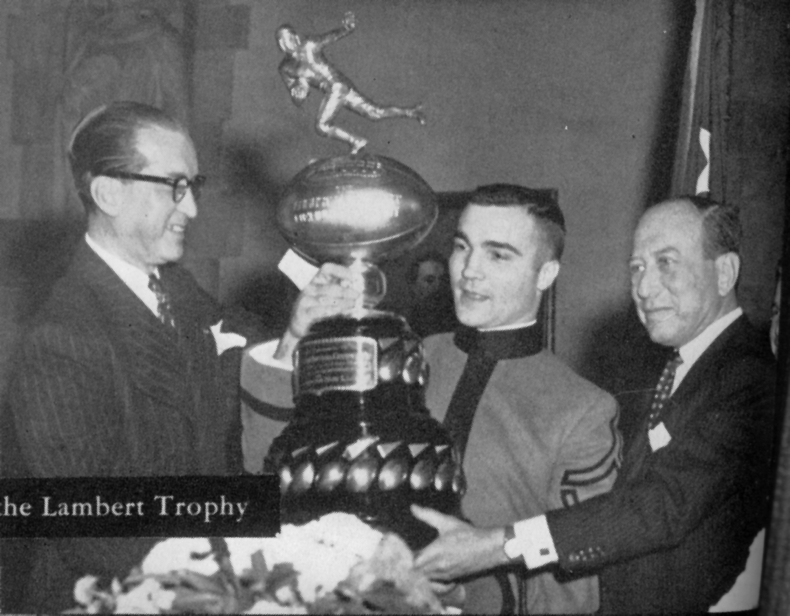
Team Captain Lunn accepting the Trophy
In 1953, Army may not have won a national championship or produced a Heisman Trophy candidate but the seven victories, including Navy and Duke; a ranking of 14 in the nation in the season's final pool; winning the Lambert Trophy; and earning Colonel Blaik "coach of the year" honors signaled the Academy's "return to glory".
The Coaching Staff
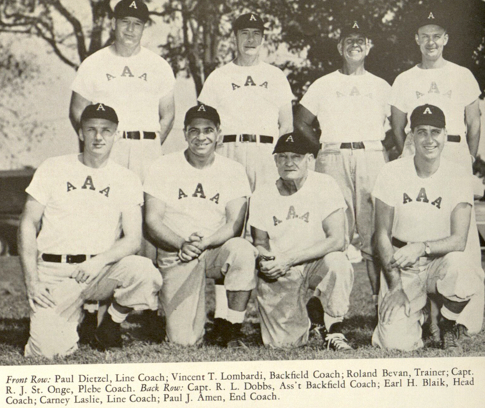
These are the Cadets who were responsible for the "Return To Glory"

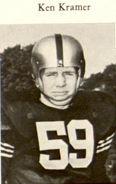
|
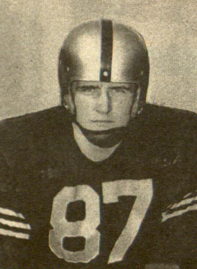 Bob Mischak participated in 3 Super Bowls, 8 AFC Championships and many playoff games. As the starting Offensive Tackle on the 1958 Giant Team he participated in "The Greatest Game Ever Played" - - yet he considers the '53 Duke Game the eptiome of any Game. Bob Mischak participated in 3 Super Bowls, 8 AFC Championships and many playoff games. As the starting Offensive Tackle on the 1958 Giant Team he participated in "The Greatest Game Ever Played" - - yet he considers the '53 Duke Game the eptiome of any Game.
|
 Lodge going down tosses to Schweikert for score. Lodge going down tosses to Schweikert for score.
 Lodge wearing #67.
|
 Freddie Attaya Freddie Attaya
 Mike Zeigler Mike Zeigler
|

 Peter Vann
|
 Tommy Bell Tommy Bell
|
 Pat Uebel Pat Uebel
|
 Bob FarrisPlayed the entire 2d half of the Navy Game totally blind in one eye. Bob FarrisPlayed the entire 2d half of the Navy Game totally blind in one eye.
|
 Ralph Chesnauskas Ralph Chesnauskas
|
 Ron Melnick Ron Melnick
|
 Unknown Unknown
|

|
 Don Holleder - 84 Don Holleder - 84
|
 Unknown Unknown
|
 Cody Cody
|
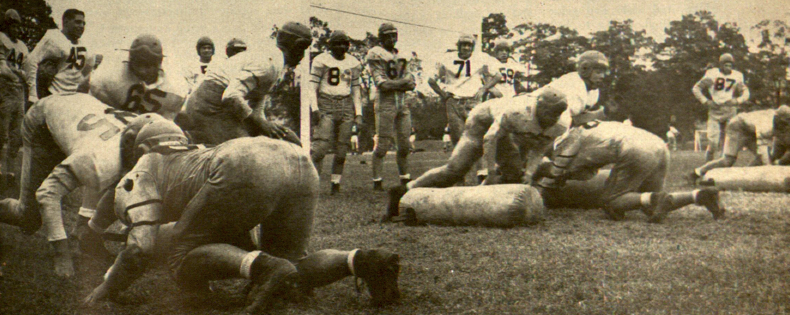 B Squad
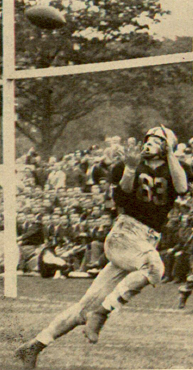 Vann to Sisson Vann to Sisson
|
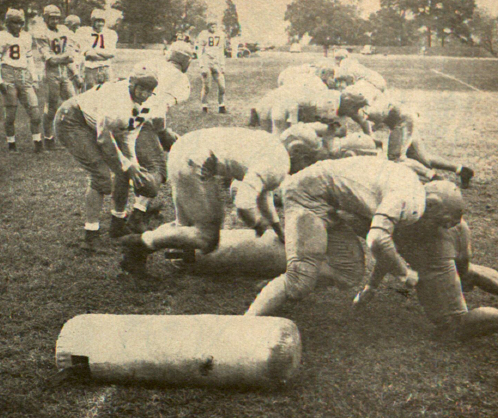 B Squad
B Squad
|
 Uebel Intercepts Uebel Intercepts
|
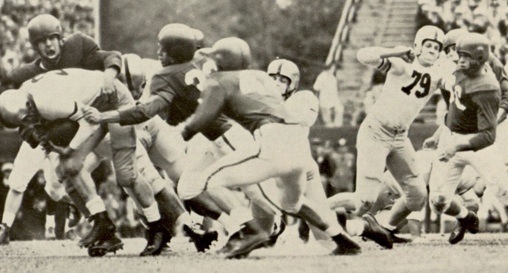 Krause driving his man to the ground
Krause driving his man to the ground
 Vann 10, Chance 38, Herdman 68
Vann 10, Chance 38, Herdman 68
|
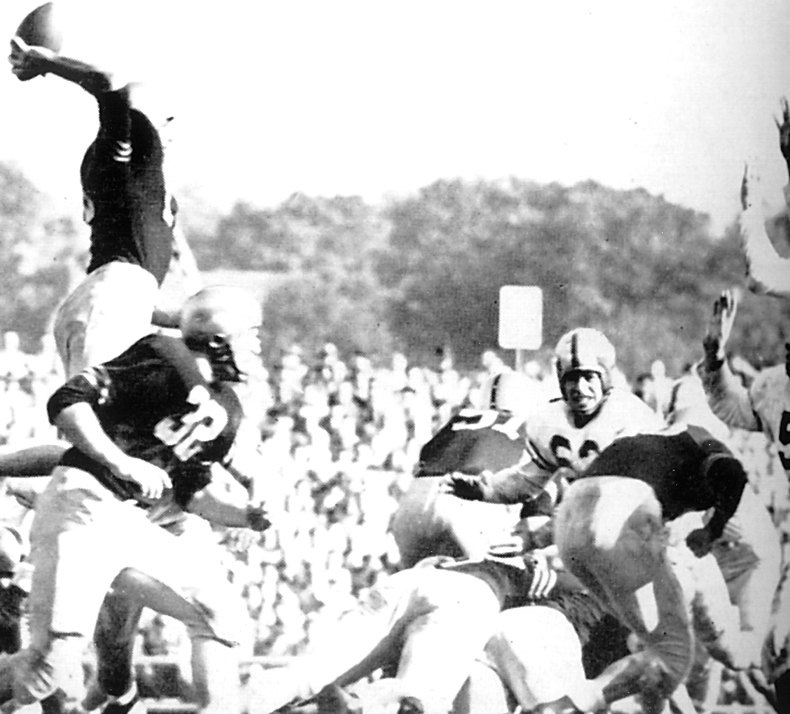
Peter takes to the Air
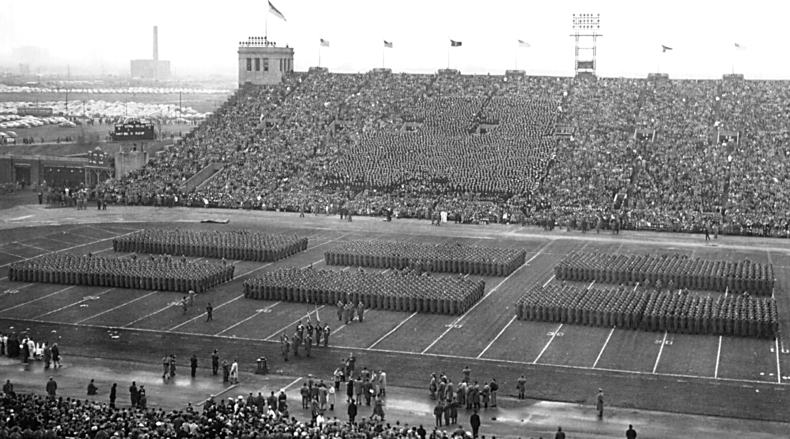
United States Corps of Cadets ready for Navy
 Sisson headed for another score Sisson headed for another score
|
 Vann moving out of the pocket
Vann moving out of the pocket
|
 Peter stuffs the ball in Jerry's gut Peter stuffs the ball in Jerry's gut
|
 Wynn
Wynn

Uebel after taking the handoff from Hagan

Attaya - Army's Fullback

Sisson - one of 3 Great Ends
|
|
 Mischak Mischak
|
 Jerry Lodge Jerry Lodge
|
 Lunn Lunn
|
 Norm Stephen Norm Stephen
|
 Jerry Lodge Jerry Lodge
|
|
|


 General MacArthur stated it would take
General MacArthur stated it would take  28th Infantry Regiment
28th Infantry Regiment 
 They played perhaps Army's Greatest Game.
They played perhaps Army's Greatest Game.


























































 General MacArthur stated it would take
General MacArthur stated it would take 


 28th Infantry Regiment
28th Infantry Regiment  They played perhaps Army's Greatest Game.
They played perhaps Army's Greatest Game.

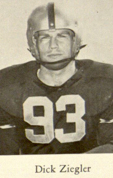
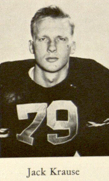

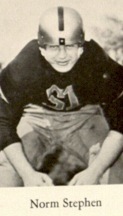
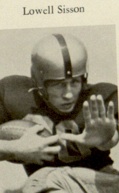













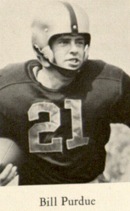



























































 Cadet Barracks
Cadet Barracks























